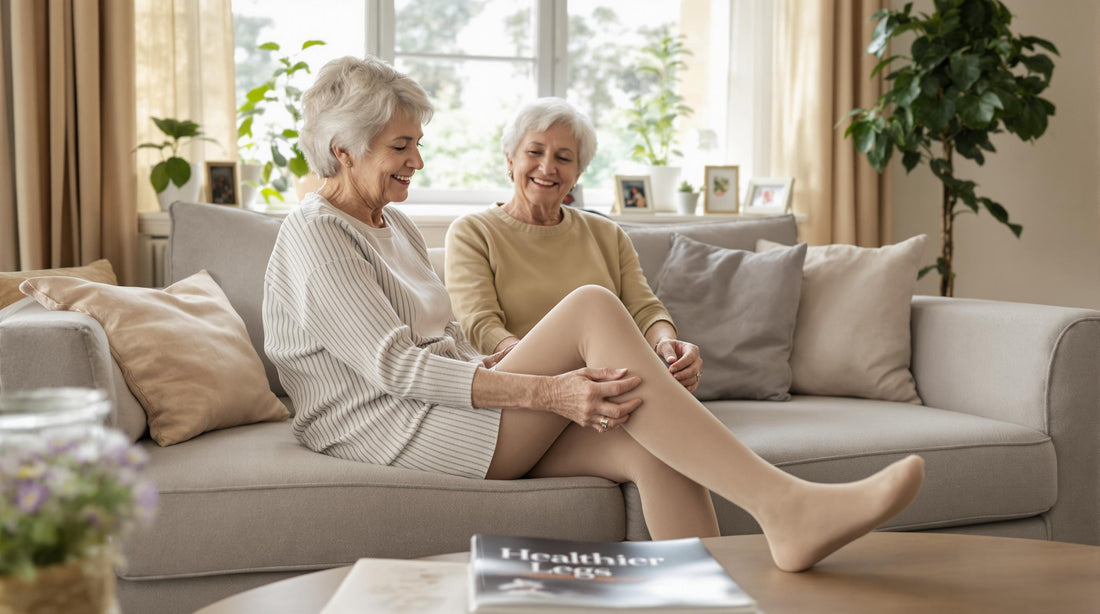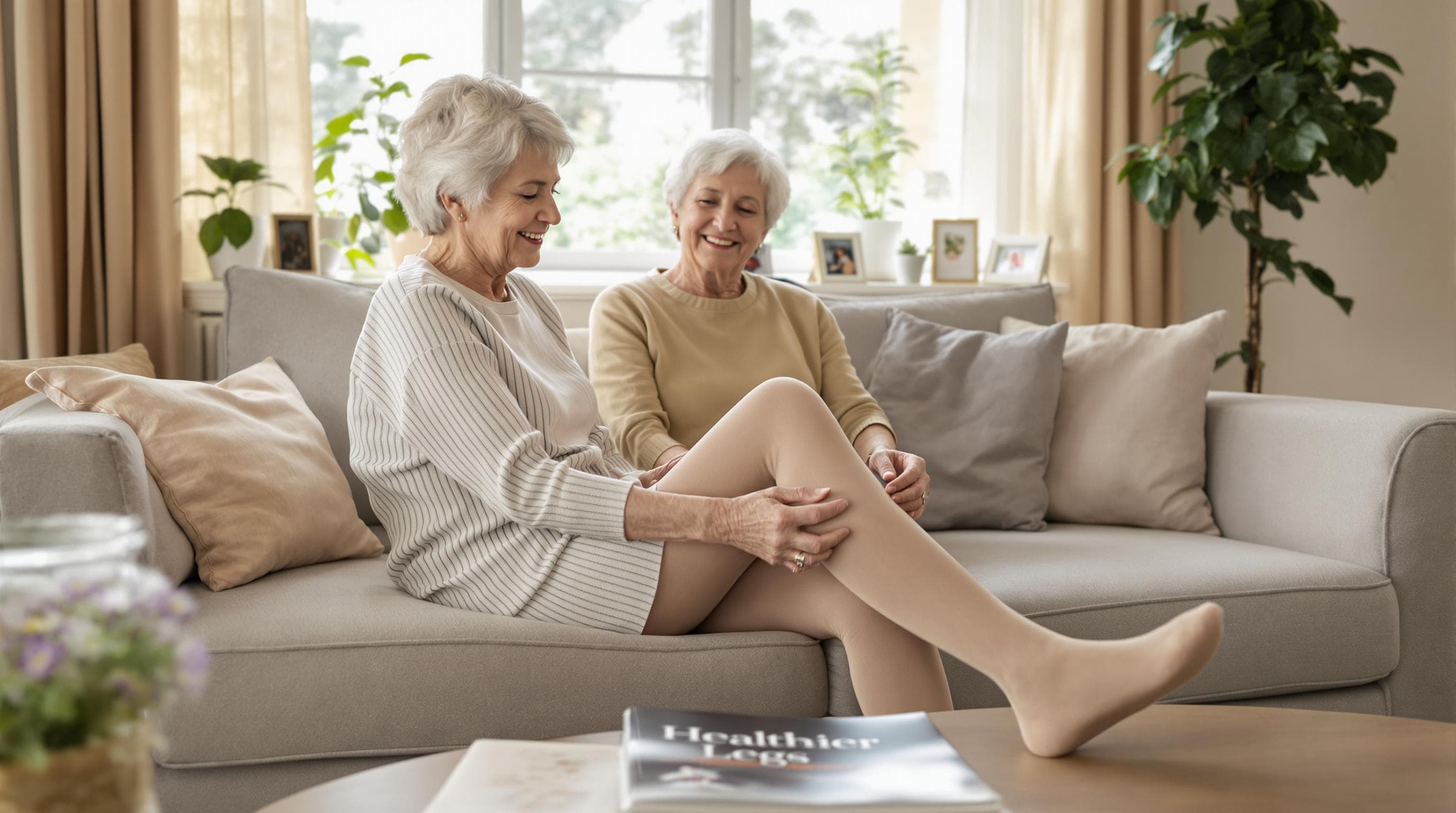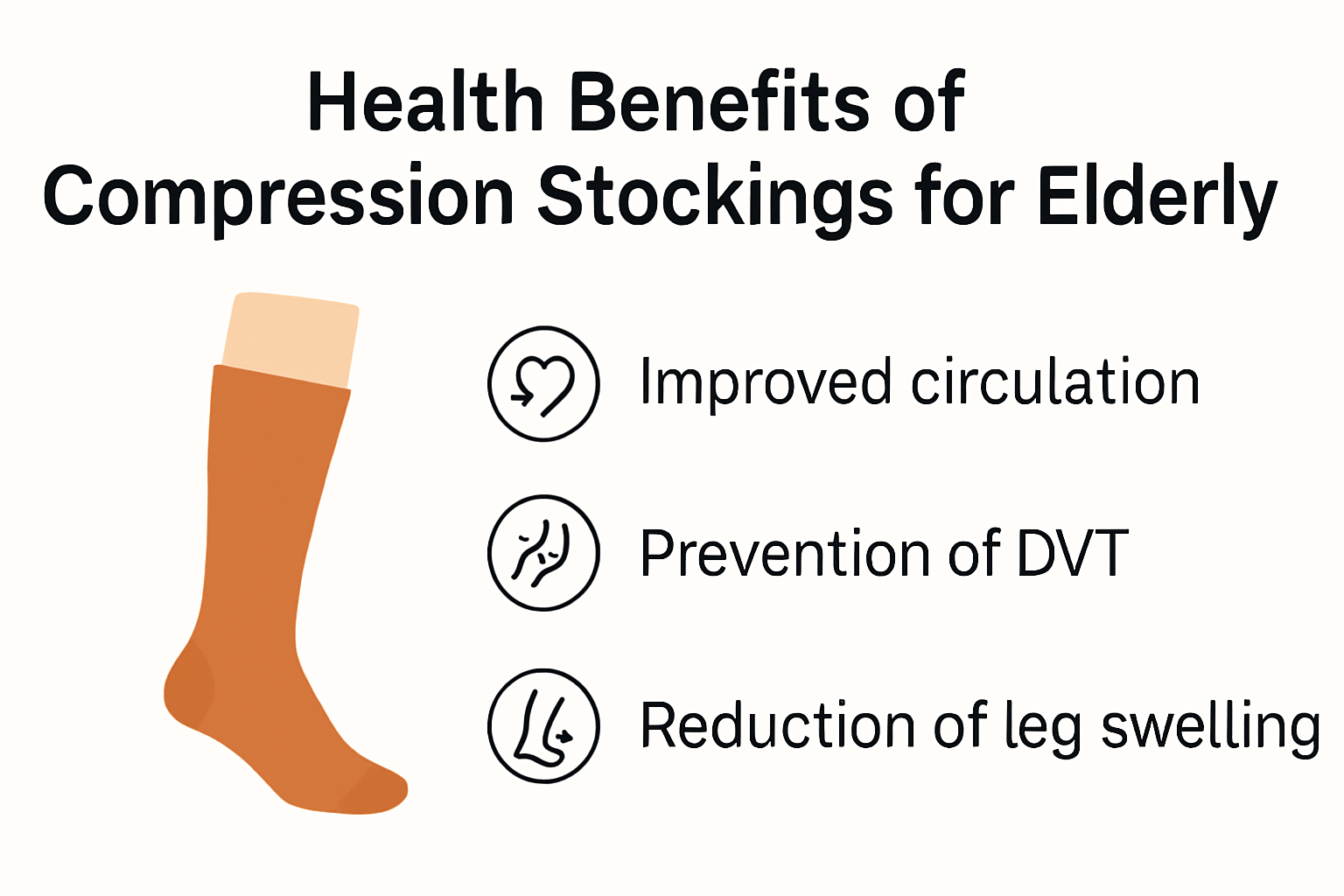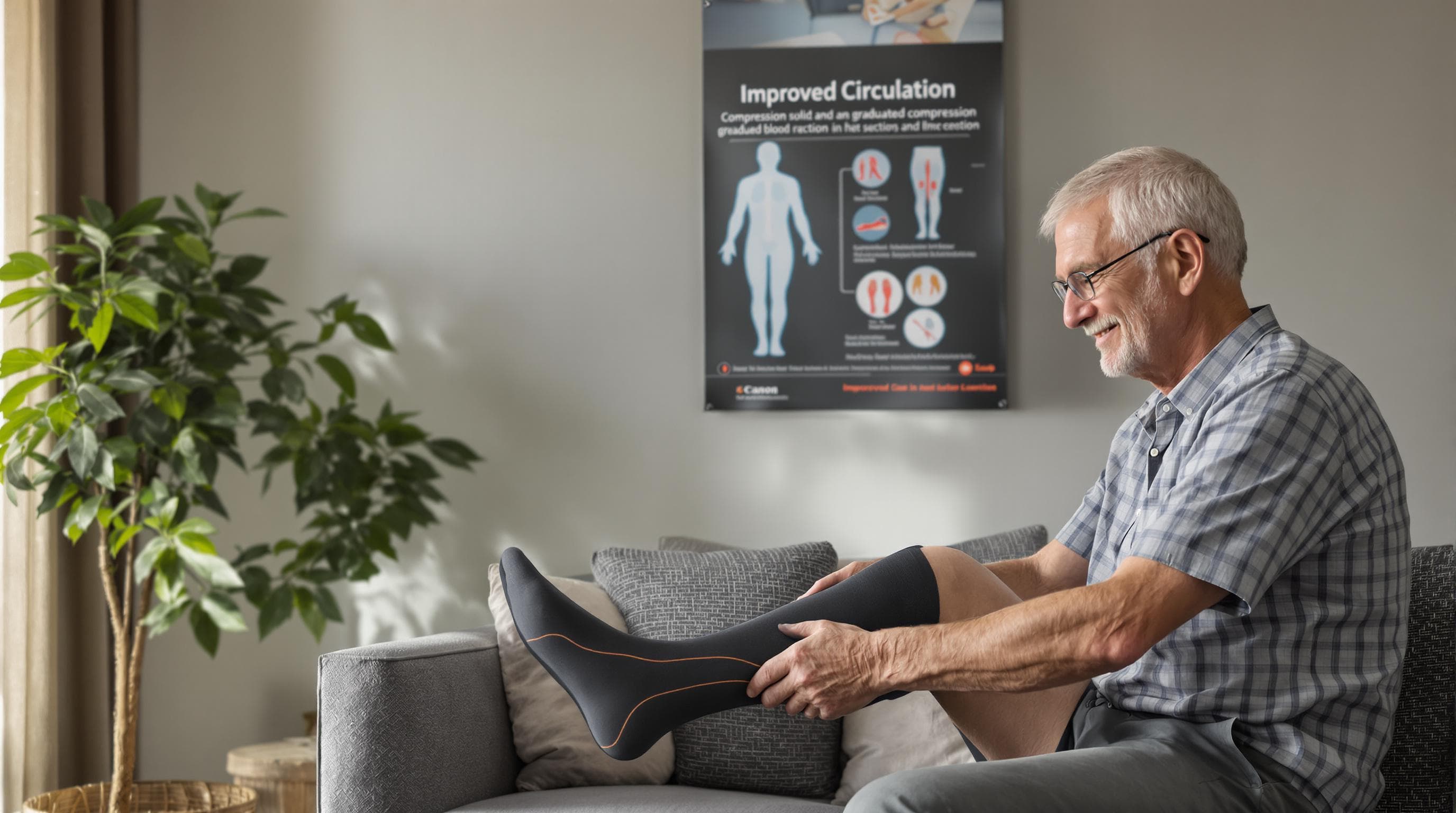
Compression Stockings for Elderly: 2025 Guide to Healthier Legs
Share

Many seniors find that leg discomfort and swelling become daily struggles as they get older. Studies show up to 70 percent of people over sixty develop some type of venous disorder, making leg health a growing concern for families everywhere. Yet most people think compression stockings are only for athletes or hospital patients. In reality, they are a vital health tool that can help elderly individuals stay mobile and independent much longer than you might expect.
Table of Contents
- Why Elderly Need Compression Stockings
- How Compression Stockings Improve Circulation
- Choosing The Right Compression Stockings For Seniors
- Tips For Safe And Comfortable Use At Home
Quick Summary
| Takeaway | Explanation |
|---|---|
| Elderly Need Compression Stockings | Compression stockings are crucial for elderly individuals to support blood circulation, addressing age-related challenges and preventing serious health risks such as DVT and chronic venous insufficiency. |
| Importance of Compression Levels | Selecting the appropriate compression level (15-20 mmHg for mild issues, 20-30 mmHg for moderate concerns) is essential for tailored health benefits; consultation with healthcare providers is recommended. |
| Proper Application and Care | Correct application techniques (like wearing in the morning and using rubber gloves) and daily maintenance practices (including hand washing and regular inspections) are vital for maximizing the effectiveness and lifespan of compression stockings. |
Why Elderly Need Compression Stockings
As people age, their circulatory system becomes less efficient, making compression stockings a critical health tool for maintaining leg wellness. The natural aging process brings significant challenges to blood circulation, creating a pressing need for targeted support that can prevent serious health complications.

Addressing Age Related Circulation Challenges
Blood circulation naturally slows down with age, increasing the risk of venous disorders and related health issues. Research from the Cleveland Clinic reveals that elderly individuals are particularly vulnerable to conditions like chronic venous insufficiency, which can lead to painful swelling, varicose veins, and potential blood clot formation.
Compression stockings work by applying graduated pressure along the leg, helping to counteract the decreased muscle efficiency that comes with aging. They essentially act as an external support system, assisting weakened veins in pushing blood back toward the heart. This mechanical assistance becomes increasingly important as muscle strength and vascular elasticity diminish.
Preventing Serious Health Risks
For seniors, compression stockings are more than just a comfort item they are a critical preventative health measure. Harvard Medical School research demonstrates that these specialized garments can significantly reduce the risk of deep vein thrombosis (DVT), a potentially life threatening condition more common in older adults.
The benefits extend beyond immediate circulation improvement. Consistent use of compression stockings can help elderly individuals:
- Reduce Leg Swelling: Minimize fluid accumulation in lower extremities
- Prevent Blood Clots: Decrease the likelihood of dangerous circulatory blockages
- Manage Chronic Conditions: Support management of diabetes related circulation issues
Understanding Compression Levels for Senior Health
Not all compression stockings are created equal, especially for elderly users. Medical professionals recommend specific compression levels based on individual health conditions. Typically, seniors might require moderate compression (15-20 mmHg or 20-30 mmHg) depending on their specific circulatory challenges.
Consulting with healthcare providers becomes crucial in selecting the right compression level. Factors like existing medical conditions, current medications, and overall physical health play significant roles in determining the most appropriate compression stocking design.
Explore our comprehensive guide on selecting the right compression stockings to understand how these medical garments can transform leg health for elderly individuals. The right support can mean the difference between limited mobility and maintaining an active, comfortable lifestyle.
How Compression Stockings Improve Circulation
The Science of Graduated Compression

Research from the Venous Forum reveals that graduated compression stockings employ a unique design principle. They apply varying levels of pressure along the leg, with maximum compression at the ankle that gradually decreases toward the thigh. This strategic pressure gradient creates a powerful pumping mechanism that actively supports blood movement against gravity.
The mechanical principle works by gently squeezing leg muscles and blood vessels, which helps push blood upward toward the heart. For elderly individuals with weakened muscle tone and reduced vascular elasticity, this external support becomes crucial in maintaining healthy circulation. The compression essentially acts like an additional layer of muscular support, compensating for natural age related declines in circulatory efficiency.
Preventing Blood Pooling and Reducing Health Risks
Cleveland Clinic research demonstrates that compression stockings are particularly effective in preventing blood pooling in the lower extremities. When blood stagnates in leg veins, it increases the risk of serious conditions like deep vein thrombosis and chronic venous insufficiency.
The benefits of improved circulation extend far beyond immediate comfort. Consistent use of compression stockings can:
- Reduce Inflammation: Minimize swelling and fluid retention in leg tissues
- Enhance Metabolic Waste Removal: Support more efficient lymphatic drainage
- Prevent Blood Clot Formation: Decrease the risk of potentially dangerous circulatory blockages
Customizing Compression for Individual Needs
Choosing the right compression level is critical for maximizing circulatory benefits. Medical professionals typically recommend compression levels based on individual health assessments. Mild compression (15-20 mmHg) might suit individuals with minor circulation concerns, while moderate to high compression (20-30 mmHg or 30-40 mmHg) could be necessary for those with more significant circulatory challenges.
Learn more about selecting the perfect compression solution to match your specific health requirements. Understanding the nuanced approach to compression can transform how you manage your circulatory health and overall wellness.
Choosing the Right Compression Stockings for Seniors
Selecting the appropriate compression stockings is a nuanced process that requires careful consideration of individual health needs, physical characteristics, and specific medical conditions. For seniors, this selection goes beyond mere comfort and becomes a critical health decision that can significantly impact overall wellness and mobility.
Understanding Compression Levels and Medical Recommendations
To clarify the distinctions between different compression levels recommended for seniors, the following table summarizes common levels, their pressure range, and typical use cases as discussed in the article.
| Compression Level | Pressure Range (mmHg) | Typical Use Cases |
|---|---|---|
| Mild Compression | 15-20 | Preventative care, minor circulatory issues |
| Moderate Compression | 20-30 | Moderate swelling, early venous disorders |
| Firm Compression | 30-40 | Severe circulatory conditions |
Yale Medicine research highlights the importance of precise compression levels for therapeutic effectiveness. Compression stockings are measured in millimeters of mercury (mmHg), with different pressure ranges addressing specific health concerns:
- Mild Compression (15-20 mmHg): Ideal for preventative care and minor circulatory issues
- Moderate Compression (20-30 mmHg): Recommended for managing moderate swelling and early stages of venous disorders
- Firm Compression (30-40 mmHg): Typically prescribed for more severe circulatory conditions
Medical professionals emphasize that seniors should never self-prescribe compression levels. Cleveland Clinic guidance strongly recommends consulting healthcare providers to determine the most appropriate compression strength based on individual health assessments.
Practical Considerations for Senior Comfort and Fit
To assist seniors in evaluating key comfort and fitting considerations when selecting stockings, the following table summarizes practical factors highlighted in the content.
| Factor | Importance for Seniors |
|---|---|
| Accurate Measurements | Ensures effective, safe compression |
| Mobility & Dexterity | Ease of use for putting on/removal |
| Skin Sensitivity | Prevents irritation and discomfort |
| Additional Health Conditions | Accounts for diabetes or skin fragility |
| Material Selection | Provides comfort, breathability, and gentleness |
Mayo Clinic experts stress the critical importance of proper sizing and fitting. Ill-fitting compression stockings can not only be ineffective but potentially harmful. Seniors should consider several key factors:
- Accurate Measurements: Professional measurements of leg circumference and length are essential
- Mobility and Dexterity: Choose styles that are easy to put on and remove
- Skin Sensitivity: Select materials that are gentle and prevent irritation
- Additional Health Conditions: Account for conditions like diabetes or skin fragility
Specialized Features for Senior Needs
Modern compression stockings offer numerous features designed specifically for elderly users. Open-toe designs provide flexibility, while seamless constructions minimize skin irritation. Some advanced models incorporate:
- Antimicrobial fabrics
- Enhanced breathability
- Additional cushioning
- Reinforced heel and toe areas
Learn more about selecting personalized compression solutions that cater to unique senior health requirements. Understanding these nuanced selection criteria ensures not just better circulation, but improved overall quality of life for elderly individuals.
Tips for Safe and Comfortable Use at Home
Compression stockings are precision medical garments that require careful handling and specific techniques to maximize their therapeutic benefits. Understanding the correct application, maintenance, and daily use can significantly enhance their effectiveness for seniors seeking improved circulation and leg health.
Proper Application Techniques
Mount Sinai medical guidelines emphasize the critical importance of correct stocking application. Seniors should prioritize morning application when leg swelling is minimal, using specific strategies to ensure smooth, wrinkle-free wear. Recommended techniques include:
- Using rubber gloves for improved grip
- Applying baby powder or cornstarch to reduce friction
- Utilizing specialized stocking donner devices for easier wear
- Smoothing out the fabric to prevent uncomfortable bunching
Mayo Clinic experts recommend daily skin inspections before and after wearing compression stockings. Look for signs of irritation, pressure marks, or changes in skin condition that might indicate improper fit or potential complications.
Daily Care and Maintenance
HealthLink BC provides comprehensive guidance on maintaining compression stockings. Proper care extends the life of these medical garments and ensures continued therapeutic effectiveness. Key maintenance practices include:
- Washing new stockings before first use to increase fabric flexibility
- Hand washing with mild detergent in lukewarm water
- Air drying away from direct heat sources
- Replacing stockings every 3-6 months or as recommended by healthcare providers
- Checking for signs of wear, such as thinning fabric or loss of elasticity
Safety Considerations and Best Practices
Seniors must approach compression stocking use with careful attention to individual health needs. Important safety considerations include:
- Consulting healthcare providers about specific wearing instructions
- Avoiding wearing stockings while sleeping unless explicitly advised
- Monitoring skin for any signs of allergic reaction or persistent discomfort
- Keeping skin clean and dry before putting on stockings
- Using barrier creams or moisturizers to prevent skin irritation
Learn more about mastering compression stocking application to ensure maximum comfort and therapeutic benefit. By following these expert-recommended guidelines, seniors can confidently integrate compression stockings into their daily health routine, promoting better circulation and overall leg wellness.
Frequently Asked Questions
What are compression stockings and why are they important for the elderly?
Compression stockings are specialized garments designed to improve blood circulation in the legs by applying graduated pressure. They are particularly important for the elderly as they help address age-related circulation challenges and prevent serious health risks, such as deep vein thrombosis (DVT) and chronic venous insufficiency.
How do I choose the right compression level for seniors?
Choosing the right compression level involves consulting with healthcare providers to assess individual health conditions. Common compression levels for seniors include mild (15-20 mmHg) for minor issues, moderate (20-30 mmHg) for moderate concerns, and firm (30-40 mmHg) for severe circulatory conditions.
Can seniors wear compression stockings while sleeping?
Seniors should generally avoid wearing compression stockings while sleeping unless specifically advised by a healthcare provider. It is best to wear them during the day when active to maximize their effectiveness in improving circulation.
How should compression stockings be applied for the best results?
For best results, compression stockings should be applied in the morning when legs are least swollen. It’s recommended to use rubber gloves for better grip, apply baby powder to reduce friction, and ensure the stockings are smooth and wrinkle-free to prevent discomfort.
Start Your Path to Safer, Healthier Legs with Trusted Compression Support
Are you worried about leg swelling, poor circulation, or the risk of blood clots discussed in our guide to compression stockings for elderly? These common challenges do not have to limit your comfort or independence. At Fit Stockings, we know that finding the right compression stockings is essential for seniors managing venous disorders, diabetes-related issues, or mobility concerns. That is why we offer a curated selection of medical-grade Jobst compression stockings in the exact pressure ranges and styles recommended by health experts. You can choose specialized products designed to fit every lifestyle including thigh-high, knee-high, and waist-high options.
Take action now to improve your circulation and regain daily comfort. Shop confidently on Fit Stockings, your source for trusted compression therapy solutions plus free shipping and easy returns. Visit our Home page today for step-by-step guidance and start protecting your leg health immediately.
Recommended
- Compression Stockings and Diabetes: What to Know in 2025 – Fit Stockings
- The Ultimate Guide to Compression Stockings: Comfort, Health, and Styl – Fit Stockings
- Knee High Compression Stockings: Health Benefits and Guide 2025 – Fit Stockings
- The Ultimate Guide to Compression Stockings: What They Are and Who Nee – Fit Stockings

